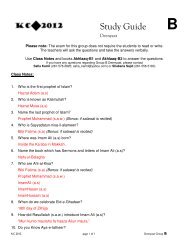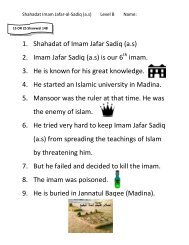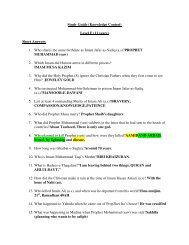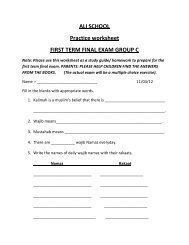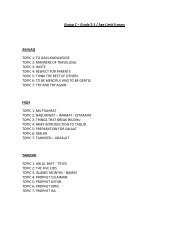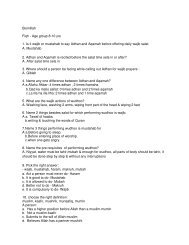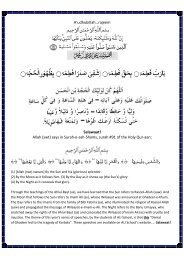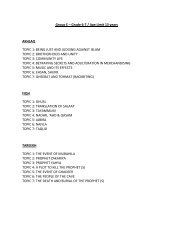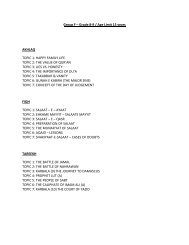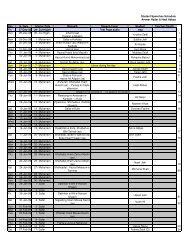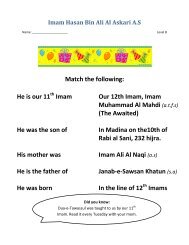The Rules of Noon Saakin and Tanween - ALI
The Rules of Noon Saakin and Tanween - ALI
The Rules of Noon Saakin and Tanween - ALI
Create successful ePaper yourself
Turn your PDF publications into a flip-book with our unique Google optimized e-Paper software.
<strong>The</strong> <strong>Rules</strong> <strong>of</strong> <strong>Noon</strong> <strong>Saakin</strong> <strong>and</strong><br />
<strong>Tanween</strong><br />
• <strong>Noon</strong> <strong>Saakin</strong> means a <strong>Noon</strong> with a<br />
Jazm/Sukoon on it.<br />
• <strong>Tanween</strong> means two Fatha (Nasb), two Kasra<br />
(Jar), <strong>and</strong> two Dhamma (Raf)<br />
• <strong>The</strong>re are four rules related to <strong>Noon</strong> <strong>Saakin</strong><br />
<strong>and</strong> <strong>Tanween</strong>.<br />
• In all <strong>of</strong> the rules, you must look at the letter<br />
after the <strong>Noon</strong> <strong>Saakin</strong> or <strong>Tanween</strong> to<br />
determine which rule to follow.
Ghunna<br />
• Ghunna is whenever a Shadda appears on<br />
<strong>Noon</strong> or Meem, one must vibrate the sound<br />
through the nose.
<strong>The</strong> Four <strong>Rules</strong> are:<br />
1. Izhaar<br />
2. Iqlaab<br />
3. Idhghaam<br />
4. Ikhfa
1. Izhaar<br />
• When the noon saakin or tanween is followed<br />
by any <strong>of</strong> the Huro<strong>of</strong> Halaqiyya, meaning the<br />
six letters that are pronounced from the<br />
throat, Izhaar will take place.<br />
• Izhaar means to pronounce the “N” sound <strong>of</strong><br />
the noon saakin or tanween clearly WITHOUT<br />
stretching it. <strong>The</strong> huro<strong>of</strong> halaqiyya are:<br />
غ خ ع ح ءه
2. Iqlaab<br />
• If there is a letter BAA after the <strong>Noon</strong> <strong>Saakin</strong><br />
or <strong>Tanween</strong>, Iqlaab will take place.<br />
• Iqlaab means to change the sound <strong>of</strong> a <strong>Noon</strong><br />
<strong>Saakin</strong> or tanween (“N” sound) into a meem.<br />
<strong>The</strong> sound will also be stretched into a<br />
Ghunna. Usually there is a little meem to<br />
signify this change. <strong>The</strong> examples:<br />
مِن بَعْ دُ أَلِيمٌ بِمَا
3. Idghaam<br />
• If after the <strong>Noon</strong> <strong>Saakin</strong> or <strong>Tanween</strong> any <strong>of</strong> the letters<br />
<strong>of</strong> يرملون (Yaa, Raa, Meem, Laam, Waaw, <strong>Noon</strong>) appear,<br />
idghaam will be done.<br />
• Idghaam means to combine or merge the “N” sound <strong>of</strong><br />
the <strong>Noon</strong> or tanween with the following letter.<br />
• In four letters, يومن (Yaa, Waaw, Meem, <strong>Noon</strong>)<br />
Idghaam will be WITH Ghunna, called Idghaam Naaqis.<br />
• Examples With Ghunna:<br />
مَن يُفْسِ دُ مَن يَقُولُ
3. Idghaam<br />
• In the two letters, ل ر (Laam <strong>and</strong> Raa),<br />
Idghaam will be without Ghunna, called<br />
Idghaam Kaamil.<br />
• Examples WITHOUT Ghunna:<br />
مُصَدِّقاً لِّمَا<br />
يَوْ ماً الَّ
4. Ikhfa<br />
• When we have learnt the above three rules, we<br />
will discover that there are fifteen letters<br />
remaining, they are:<br />
ك<br />
ق ف ظ ط ض ص ش س ز ذ د ج ث ت • Whenever any <strong>of</strong> these fifteen letters appear<br />
after <strong>Noon</strong> <strong>Saakin</strong> or <strong>Tanween</strong>, Ikhfa will be done.<br />
• Ikhfa means to slightly “hide” the “N” sound <strong>of</strong><br />
the <strong>Noon</strong> <strong>Saakin</strong> <strong>and</strong> <strong>Tanween</strong>, bring the shadow<br />
<strong>of</strong> the letter, <strong>and</strong> lengthen it slightly.



